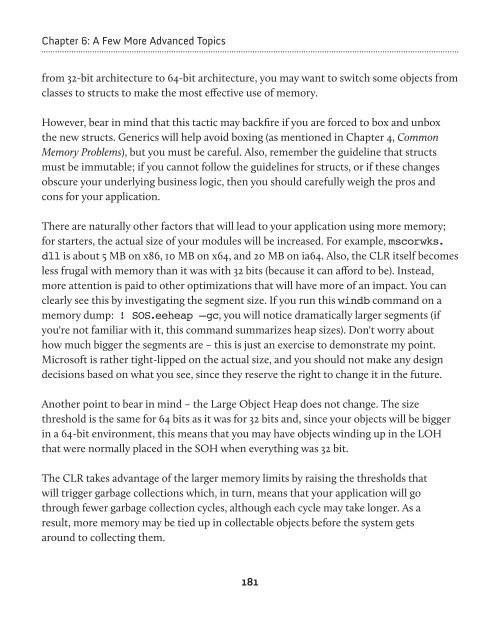Under the Hood of .NET Memory Management - Simple Talk
Under the Hood of .NET Memory Management - Simple Talk
Under the Hood of .NET Memory Management - Simple Talk
Create successful ePaper yourself
Turn your PDF publications into a flip-book with our unique Google optimized e-Paper software.
Chapter 6: A Few More Advanced Topics<br />
from 32-bit architecture to 64-bit architecture, you may want to switch some objects from<br />
classes to structs to make <strong>the</strong> most effective use <strong>of</strong> memory.<br />
However, bear in mind that this tactic may backfire if you are forced to box and unbox<br />
<strong>the</strong> new structs. Generics will help avoid boxing (as mentioned in Chapter 4, Common<br />
<strong>Memory</strong> Problems), but you must be careful. Also, remember <strong>the</strong> guideline that structs<br />
must be immutable; if you cannot follow <strong>the</strong> guidelines for structs, or if <strong>the</strong>se changes<br />
obscure your underlying business logic, <strong>the</strong>n you should carefully weigh <strong>the</strong> pros and<br />
cons for your application.<br />
There are naturally o<strong>the</strong>r factors that will lead to your application using more memory;<br />
for starters, <strong>the</strong> actual size <strong>of</strong> your modules will be increased. For example, mscorwks.<br />
dll is about 5 MB on x86, 10 MB on x64, and 20 MB on ia64. Also, <strong>the</strong> CLR itself becomes<br />
less frugal with memory than it was with 32 bits (because it can afford to be). Instead,<br />
more attention is paid to o<strong>the</strong>r optimizations that will have more <strong>of</strong> an impact. You can<br />
clearly see this by investigating <strong>the</strong> segment size. If you run this windb command on a<br />
memory dump: ! SOS.eeheap –gc, you will notice dramatically larger segments (if<br />
you're not familiar with it, this command summarizes heap sizes). Don't worry about<br />
how much bigger <strong>the</strong> segments are – this is just an exercise to demonstrate my point.<br />
Micros<strong>of</strong>t is ra<strong>the</strong>r tight-lipped on <strong>the</strong> actual size, and you should not make any design<br />
decisions based on what you see, since <strong>the</strong>y reserve <strong>the</strong> right to change it in <strong>the</strong> future.<br />
Ano<strong>the</strong>r point to bear in mind – <strong>the</strong> Large Object Heap does not change. The size<br />
threshold is <strong>the</strong> same for 64 bits as it was for 32 bits and, since your objects will be bigger<br />
in a 64-bit environment, this means that you may have objects winding up in <strong>the</strong> LOH<br />
that were normally placed in <strong>the</strong> SOH when everything was 32 bit.<br />
The CLR takes advantage <strong>of</strong> <strong>the</strong> larger memory limits by raising <strong>the</strong> thresholds that<br />
will trigger garbage collections which, in turn, means that your application will go<br />
through fewer garbage collection cycles, although each cycle may take longer. As a<br />
result, more memory may be tied up in collectable objects before <strong>the</strong> system gets<br />
around to collecting <strong>the</strong>m.<br />
181











